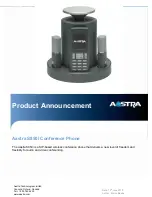
System Speed Dial
System speed dialing provides system users with a repertory of up to 500 numbers that they can dial from
any telephone in the system. The programmer or the attendant is responsible for storing the system speed
dial numbers. These numbers can be up to 32 digits long and can include line number selection, the dial
pad digits 0-9,
✻
, and #, Plus pauses and hookflash signals.
The programmer or attendant can divide the unused or available system speed dial numbers into up to 50
different groups with 10 numbers in each group and then assign different speed dial groups to each station
class of service (total of 500).
The program can choose a line a line group that the system will automatically select for speed dialing.
Alternately, the programmer or attendant can choose the intercom to be automatically selected for speed
dialing. This enhancement allows an intercom selection and feature codes to be stored together as speed
dial numbers for true one-button access to features (for example; store INTERCOM
✼
11 and
INTERCOM #1 at two locations for system wide availability to music on and music off). This
enhancement will not accept
✼
#0
✼
or
✻
#746
✻
as programming entries and it ignores any entered pauses
or hookflashes.
System Status And E1–T1 Status Log Viewing
When enabled, this feature permits the system to light a system status light to notify certain designated
stations when a system error condition occurs. You can view the status log directly from an LCD
speakerphone. If the E1 or T1 option is installed, you can also view the status log from an LCD
speakerphone in the same manner.
Your LCD speakerphone must have a pre-programmed system status button to enter the status log
viewing mode. The status button is programmed using the button mapping procedure in the Programming
Instructions. The LCD status log viewing feature allows you to view the log only. The installer must use
programming to clear the log.
To enter the log viewing mode, you press the system status button (the system status button flashes red if
any log entries exist). The LCD indicates
SYSTEM
and
E1
(if the E1 option is installed) or
T1
(if the T1
option is installed). Select the log you want to view by pressing the related interactive button. If you are
using a telephone that is not equipped with interactive buttons, you can use dial pad buttons 1, 2, and 3
that perform the same functions as the interactive buttons. See the following chart.
Interactive Button
Location Displayed Function
Equivalent Dial Pad Button
Left
SYSTEM,
1
Left
REV
1
Center
FWD
2
Right,
T1
3
Right,
INFO
3
After selecting the log you want to view, you can view the time and date of the current log entry by
pressing the INFO interactive button (or dial pad button 3 when appropriate). You can scroll through the
selected log to view all of the entries by pressing the REV and FWD interactive buttons (or dial pad
buttons 1 and 2 when appropriate).
The number of entries in the log is displayed whenever you press the # button.
You exit the log viewing mode either by pressing the SPEAKER button, pressing the hookswitch, or
waiting for the 15-second time-out.
GCA40–130
DXP Plus General Description
106 – Understanding The Features
















































